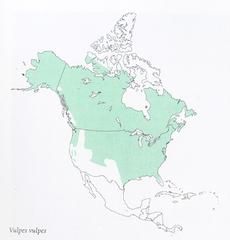|
|
Overview |
Habitat
Red foxes prefer broken, sparsely settled country. Ideal
habitat is provided by farmland mixed with sparsely wooded
areas, brushland, and streams.
Conservation Biology
- Special Protection Status
- Rangewide:
None.
- In Park:
All plants and animals are protected within
Great Smoky Mountains National Park. Collection
requires a permit which is usually granted only
for research or educational purposes.
|
|
|
Identification |
- Adult total length:
35 - 42 in. (900 - 1070 mm)
- Tail:
14 - 16 in. (350 - 400 mm)
- Hind foot:
4 3/4 - 7 1/4 in. (124 - 182 mm)
- Weight:
6 - 15 lbs. (2.7 - 6.7 kg)
-
Physical Characteristics:
The red fox is normally rusty-reddish to reddish-
yellow on its dorsal surface with darker hairs
often being intermixed down the middle of the back.
The fronts of the legs and feet are black, and the
underparts are whitish. The ears are large, pointed,
and erect, and the muzzle is sharp and elongate.
The long, bushy tail has a white tip.
|
|
|
Names | |
|
|
|
Phylogeny |
| Taxonomic Category |
Scientific Name |
Common Name |
| Phylum |
Chordata |
Chordates |
| Class |
Mammalia |
Mammals |
| Order |
Carnivora
|
Dogs, Cats, Bears, etc. |
| Family |
Canidae |
Wolves, Foxes |
|
|
|
Geographic distribution |
The range of the red fox extends from Alaska throughout all but the
extreme north of Canada; south in the Cascade-Sierra Nevada chain
to central California and in the Rocky Mountain chain to southern
New Mexico; east of the plains, south to central Texas, southern
Alabama, and western Florida.
-
Range Maps
| North America |

|
|
-
Great Smoky Mountains National Park:
The red fox has been observed at all elevations in the park.
- Blount Co.:
Spence Field (5,000 feet).
- Cocke Co.:
Cosby.
- Sevier Co.:
Park headquarters; Greenbrier Cove; near
Metcalf Bottoms; Dudley Creek; Boulevard
Trail; Indian Gap; Mt. LeConte.
- Haywood Co.:
Walnut Bottom; between Big Creek and
Davenport Gap; Little Bald Knob; Spruce Mountain.
- Swain Co.:
Along Forney Creek Road; Straight Fork;
between Bryson Place and the Tenn.-N.C. line;
Becks Bald (4,600 feet).
|
|
|
Natural history |
- Reproduction
Litters averaging four to seven pups are usually born
in March or April. The den may consist of an enlarged
woodchuck burrow or a natural cavity. Since red foxes
are not good diggers, the den is often in loose soil
on a wooded slope or in an open field. Pups reach their
adult size in about six months and disperse in September
and October.
- Longevity
Most wild foxes probably survive two to four years,
although the record is 8 1/2 years (
Linzey, 1995a).
- Terrestrial Ecology
Although these foxes are primarily nocturnal, they may
be abroad at any hour during all seasons. The senses of
sight, smell, and hearing are well developed. Red foxes
are masters at eluding human and animal enemies.
Red foxes feed on a variety of animal and plant foods
including cottontails, mice, insects, birds, turtles,
snakes, carrion, and fruit. Stupka found grasshoppers
(Schistocerca) in the stomachs of two foxes from
Indian Gap and along The Boulevard Trail in December.
On September 12, 1944, seven freshly killed short-tailed
shrews were noted along 1 1/2 miles of the Appalachian
Trail just prior to the obsevation of a red fox in that
area by a group of hikers (Stupka).
- Predators and Defense
Young foxes are preyed upon by a variety of raptors and
carnivores. Coyotes will kill adult red foxes. Otherwise,
they have few enemies other than humans and their automobiles.
- Parasites
None recorded from the park.
|
|
|
Links to other sites | |
|
|
|
References |
-
Lariviere, S. and M. Pasitschniak-Arts. 1996.
Vulpes vulpes. Mammalian Species No. 537: 1-11.
American Society of Mammalogists.
-
Linzey, D. W. 1995a.
Mammals of Great Smoky Mountains National Park.
Blacksburg, Virginia: The McDonald & Woodward Publishing Company, Inc.
-
Linzey, D. W. 1995b.
Mammals of Great Smoky Mountains National Park-1995 Update.
Journal of the Elisha Mitchell Scientific Society 111(1):1-81.
-
Linzey, D. W. 1998.
The Mammals of Virginia. Blacksburg, Virginia:
The McDonald and Woodward Publishing Company.
-
Seidensticker, J. 1999.
Red fox. Pages 150-152 . In: D. E. Wilson, and S. Ruff (eds.).
The Smithsonian Book of North American Mammals.
Washington, D. C.: Smithsonian Institution Press.
-
Stupka, A. 1935-63.
Nature Journal, Great Smoky Mountains National Park. 28 vols.
(years) each with index. (Typewritten copy in files of Great
Smoky Mountains National Park.)
|
|
|
Acknowledgements |
- Text
- Photographs
- Map development
- Web page design & coding
- Denise Lim, University of Georgia, Athens
- John Pickering, University of Georgia, Athens
|
|
| Supported by | |
|
Following modified from Australian Faunal Directory
|
Top | See original
| &pull 20q v5.145 20180528: Error 301 Moved Permanently http://biodiversity.org.au/afd/taxa/2869ce8a-8212-46c2-8327-dfb7fabb8296 |
|
Following modified from University of Georgia Museum of Natural History
|
Top | See original
| &pull 20q v5.145 20180528: Error 301 Moved Permanently http://naturalhistory.uga.edu/~GMNH/gawildlife/index.php?page=speciespages/species_page&key=vvulpes |
|
Following served from A. Murie, American Society of Mammalogists |
Top | See original context
|
Following modified from North American Mammals, Smithsonian Institution
|
Top | See original
| &pull 20q v5.145 20180528: Error 301 Moved Permanently http://www.mnh.si.edu/mna/image_info.cfm?species_id=420 |
Updated: 2024-04-26 14:23:26 gmt
|
